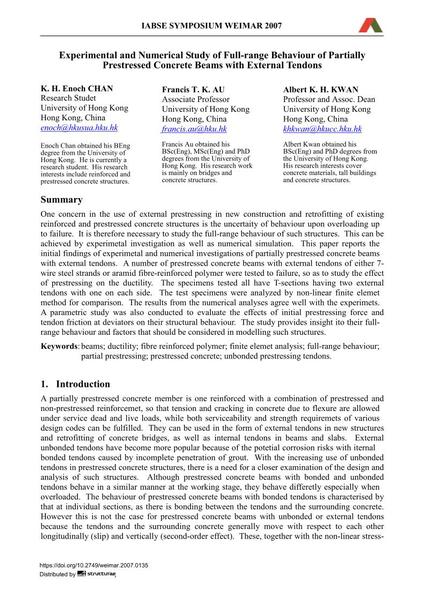Experimental and Numerical Study of Full-range Behaviour of Partially Prestressed Concrete Beams with External Tendons

|
|
|||||||||||
Détails bibliographiques
| Auteur(s): |
K. H. Enoch Chan
Francis T. K. Au Albert K. H. Kwan |
||||
|---|---|---|---|---|---|
| Médium: | papier de conférence | ||||
| Langue(s): | anglais | ||||
| Conférence: | IABSE Symposium: Improving Infrastructure Worldwide, Weimar, Germany, 19-21 September 2007 | ||||
| Publié dans: | IABSE Symposium Weimar 2007 | ||||
|
|||||
| Page(s): | 456-457 | ||||
| Nombre total de pages (du PDF): | 8 | ||||
| Année: | 2007 | ||||
| DOI: | 10.2749/weimar.2007.0135 | ||||
| Abstrait: |
One concern in the use of external prestressing in new construction and retrofitting of existing reinforced and prestressed concrete structures is the uncertainty of behaviour upon overloading up to failure. It is therefore necessary to study the full-range behaviour of such structures. This can be achieved by experimental investigation as well as numerical simulation. This paper reports the initial findings of experimental and numerical investigations of partially prestressed concrete beams with external tendons. A number of prestressed concrete beams with external tendons of either 7- wire steel strands or aramid fibre-reinforced polymer were tested to failure, so as to study the effect of prestressing on the ductility. The specimens tested all have T-sections having two external tendons with one on each side. The test specimens were analyzed by non-linear finite element method for comparison. The results from the numerical analyses agree well with the experiments. A parametric study was also conducted to evaluate the effects of initial prestressing force and tendon friction at deviators on their structural behaviour. The study provides insight into their fullrange behaviour and factors that should be considered in modelling such structures. |
||||
| Mots-clé: |
poutres
|
||||
